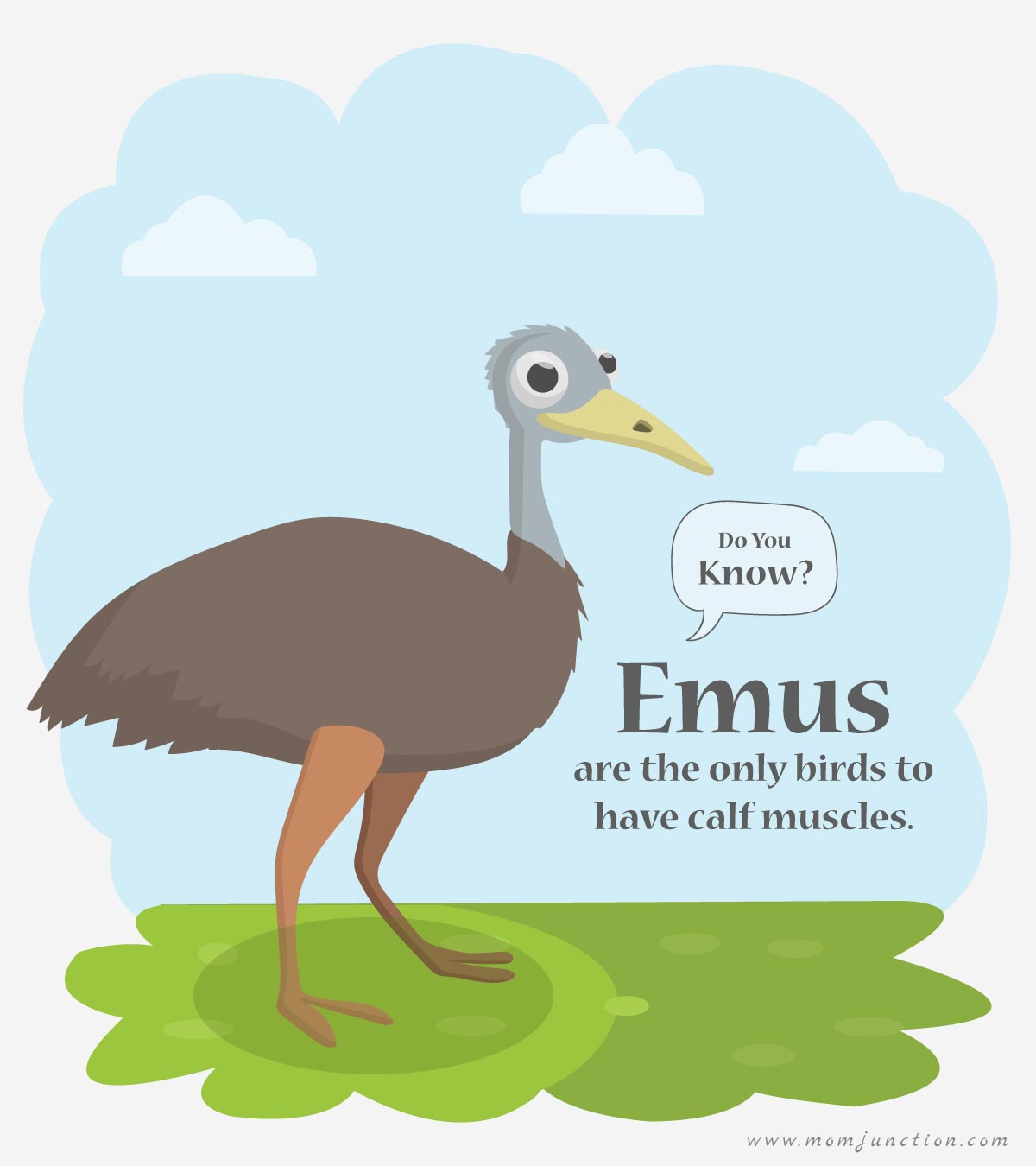
Image: ShutterStock
Emu is a six-foot-tall fascinating bird known for its unique height and fluffy feathers. Since the bird ignites curiosity amongst children, we share some interesting facts about emu for kids. This post presents various emu facts for kids including its height, abode, peculiar features, and social life.
Educating your child about this attractive, tall bird can acquaint them with diversity in nature and enhance their understanding of wildlife in general. So, wait no more and scroll down to find some of the most interesting, engaging, and fun facts about emu.
10 Fun Emu Facts For Kids
- Emus are the only birds to have calf muscles.
- Emu’s meat contains less sodium than beef, turkey, and chicken.
- Emus possess a pouch in their windpipe, which they use for communication.
- The tail feathers of an emu are quite stiff, and the birds rattle them to scare off predators.
- Emu can swim as well as sit in water with ease.
- Emus like to steal food from unsuspecting campers and tourists. So, if emus are around while you are eating, keep a watch on your food.
- Emus have sharp eyesight and hearing senses.
- Emus are vigilant birds that are alert at night as they are susceptible to predators.
- The US started importing the emus between 1930 and 1950.
- The Australian Government has built hundreds of miles of fencing to safeguard emu and restrict their migration to open forests and plains.
20 Interesting Emu Information For Kids
1. What Is Emu?
Emu, scientifically called Dromaius novahollandiae, is the second largest bird on the earth after ostrich and the only extant of genus Dromaius. This huge bird has been there since the era of dinosaurs i.e. 80 million years ago. Initially, three species of emu thrived on the earth, but two of them (Tasmanian and Kind Island emu) got extinct post-European settlement in Australia in 1788. Emu belongs to the ratite family, which includes flightless birds such as ostrich, rhea, cassowary, emu, and kiwi.
2. Where Do Emus Live?
Emu is endemic to Australia, and you cannot find the bird anywhere else. It is popular as the largest native bird. Emus like to live in open areas. Here are a few facts on their habitats:
- Emus prefer to live in woodlands, forests, grasslands, and scrublands.
- You can find them near the coast and inland Australia.
- Very few emus reside in desert areas.
- Emus avoid staying in dense forests and rainforests and densely populated areas of Australia.
3. How Does An Emu Appear?
Emus have distinct body features that give them a peculiar appearance. Here, we list various physical features of an emu.
- Height And Weight: Generally, emus are about two meters in height i.e. approximately six feet.
- Wings: They possess small, black wings that help them calm themselves when the weather is hot. Feathers of an emu grow in pairs having two connected shafts at the base. Emus are the only birds with double feathers. They hold their wings out to let the air circulate. Unique feather arrangement makes the bird’s body covered with hair. An emu wet in rain appears bedraggled.
- Weight And Size: Female emus are larger in size than male birds. An average female emu is about 40kg in weight while a male bird weighs about 36kg.
- Neck And Skin: The entire body of the emu is filled with feathers, but its neck often lacks feathers. It has a bluish skin color.
- Beaks: Emus have soft but broad nibs that facilitate easy browsing in a busy area and help graze the grass conveniently.
- Legs And Toes: Emus possess two long legs, and each leg has a claw. You can find three large toes on each leg. Legs are strong enough for a fast run. Nails of an emu’s toes resemble the blade of a knife.
4. Emus Have Unique Eyelids:
Emus possess two eyelids. This bird blinks with one eyelid while the other eyelid prevents the entry of sand and dust into its eyes.
5. How Fast Do Emus Run?
Emus are famous for their fast running. This tall bird runs at a high speed of 30 miles per hour.
6. What Do Emus Eat?
Emus are omnivorous birds, so they eat both plants as well as animals.
- Emus like to eat grass, grains, worms, slugs, snails, bugs, berries, flowers, vegetables, grasshoppers, and some fruits.
- They drink about one to four gallons of water daily, particularly in the hot weather conditions.
- When emu gets nutritious feed, they tend to eat about one-and-a-half pounds daily. If they get poor quality food, then they consume greater quantity to meet their nutritional requirements. During the days when the daytime is shorter than usual, emus experience reduced appetite.
- Emus store high amounts of fats in their bodies to use them to survive in days when food is scarce.
- Droppings of this bird are big and soft. If an emu notices undigested seeds in its droppings, then it picks and eats them.
- Emus also swallow stones to promote grinding of the food in their gizzard.
7. Do Emus Emit Any Sound?
Female emus emit a loud booming sound during the breeding season, and male birds emit a grunting sound just like a pig. Emus have the ability to regulate the pitch of their sound. The high intensity of emu’s booming sound is audible as far as 2km. Females make a low-intensity sound for attracting males. Emus make the high-intensity sound while males are incubating the eggs. At times, booming and grunting sounds are made for territorial defense, to protect their eggs from intruders.
8. Behavior Of Emus:
Emus are not aggressive, but docile and curious birds. You can easily tame them. Most often, you will find emus traveling in pairs. Even though these birds can form large flocks and travel, they prefer to fly in pairs on account of their common need to move towards new food sources. Emus travel long distances to discover productive feeding areas. For instance, you will find emus in Western Australia following a peculiar seasonal pattern of flying to the north in summer and south in the cold season.
9. Do Emus Swim?
Yes, emus swim if required and they like to play in the water. On hot days, you could find emus at water streams kicking their legs in the air and rolling on their backs. Emus are excellent swimmers so they can cross rivers with ease while looking for new feeding areas. They travel several miles every year.
10. Do Knees Of Emus Bend Forward?
No, emu’s knees do not bend forward; it’s a myth. When an emu sits on the ground, its feet appear to fold in the front. Even if it seems that the knee of the emu bends forward, the fact is the knee is present high up under the feathers so we can’t see them and the bending leg area we see are the ankles of the bird.
11. How Do Emus Breed?
Emus form their pairs in summer and breed in the cold months of the year. Their breeding season begins in August or September and the egg-laying season starts in September or October. Emus breed in a unique pattern.
- They start laying eggs before they turn two years old as their growth is quite fast. Regarding emu’s reproduction, its productive life is greater than 20 years, and it can lay an egg even after it turns 25.
- The blue skin develops on the neck area of a female emu, and its feathers turn dark brown. The female bird walks around the male emu making some peculiar sounds signifying the mating period.
- Male emu creates a nest in a hollow on the earth by using grass, leaves, bark, and sticks. Every three days, the female emu lays dark green, thick shell eggs weighing one pound and stretching up to seven inches in length. After the female lays the seventh egg, male emu sits on them to incubate them. The female continues to lay more eggs. An emu’s nest comprises about ten eggs or even more.
- Male emu sits on the eggs in the nest for about eight weeks thriving on the stored body fats and morning dew. He gets up about ten times a day only to turn over the eggs.
12. How Do Chicks Of Emu Appear?
Cream colored babies of emu have dark stripes from their head to tail. They are about ten inches tall and have fluffy feathers on their bodies. The chicks are highly active, and they leave the nest a few days after coming out. They turn two pounds in weight in a year. Emu’s chicks stay with the father emu for about 18 months.
13. Who Are Predators Of Emus?
Common predators of emus include eagles, hawks, foxes, goannas, dingoes, dogs, cats, and humans. Also, lizards attack and eat emu’s eggs.
14. Can Emus Defend Themselves?
Emus can efficiently defend themselves as their forward kicks are incredibly powerful. Also, females make the loud booming sound for keeping predators away from their eggs when male emus are incubating them.
15. Humans Practice Emu Farming:
Emu farming is popular as an alternative agriculture. You only need a breeding emu pair and 100 feet long and 25 feet wide well-fenced land having a proper shelter for the protection of emus. Fences need to be greater than five feet tall for emu farming.
Cindy Brenneke, the owner of the ‘Where Pigs Fly’ farm, talks about her pet Emu Emma and shares some interesting facts. She says, “Once the Emu chicks hit about three months old, unfortunately, their stripes disappear, but they’re still beautiful… like the caveman, the Emu is nomadic, this means it eats and enjoys, and then it moves on… They may look intimidating with those dinosaur-looking feet with talons that can cut like knives. Despite this power, emus are not known to kill humans or to even fight with them (i).”
16. Do Emus Adapt To The Changing Climate?
Emus adapt to the changing temperature and extreme climates. This bird can survive in a temperature varying from less than zero degrees to greater than 100 degrees. As emus drink water daily, their lungs act as evaporative coolers in hot climatic conditions. When the climate is cold, the multiple folds of their nasal airways recycle the air and generate moisture to adapt to the atmosphere. Also, emus suffer from no common disease and lead a healthy life.
17. How Are Emu’s Feathers, Skin, And Other Parts Used?
People used to hunt emus for their skin, meat, oil, and feathers, but now you get them from farm emus. Some of the common uses of emu’s parts are:
- Emu’s Skin: The skin of an emu is supple and soft. People use it as a quill-patterned leather for creating fashion accessories and clothes.
- Emu Oil: Aboriginal Australians extract oil from emu’s fatty tissues present beneath its skin to treat pain, headaches, arthritis, and many other ailments. Also, emu’s oil is rich in various vitamins and acids, so it is used in pharmaceutical and cosmetic products.
- Meat: Emu’s meat is low in fats, i.e. about 97% free of fats, rich in proteins. The meat contains higher vitamin C and iron content than beef and less cholesterol than chicken.
- Feathers And Eggshells: People use feathers and eggshells of the emu to develop creative crafts, jewelry, and other items.
18. What Is The Lifespan Of Emus?
In wild environments, emus can survive for about ten to 20 years. However, in captivity, they can live up to 35 years.
19. Are Emus A Threatened Bird Species?
In spite of being endemic to Australia, emus are not yet threatened. However, in the northern territory of Australia, surveys and researchers classify emus as vulnerable bird species.
20. Why Emu Is Present On Australia’s ‘Coat Of Arms’?
Australia’s coat of arms, an official badge, has an emu on its one side and red kangaroo on other. Emu and kangaroo not only signify the tallest creatures endemic to Australia but also both of them never move backward so they tend to represent a nation that always steps forward for progress.
Frequently Asked Questions
1. Do emus have teeth?
No, emus do not have teeth. Instead, they have a tough beak that they use to tear and grind food. In addition, Emus have a gizzard in their digestive system that helps grind tough plant material. (1).
2. How high can an emu jump?
Emus can jump to a height of up to 7 feet (2.1 meters). They use their strong legs and sharp claws to clear obstacles and escape predators in the wild. When frightened, emus can run up to 30 miles per hour (48 km/h) and jump and kick to defend themselves (2).
Did you share any of the above interesting facts and information of emus with your kids? Which emu facts did your child find fascinating? Share your experience and knowledge with fellow moms by leaving a comment below.
Infographic: Amazing Facts About Emu For Children
Emus are large flightless birds with short bodies and long legs that can easily get your children’s attention. So, when visiting a zoo, take this opportunity to teach your children about Emus when they ask you about these fascinating creatures. We’ve provided a few interesting facts about Emus in the infographic below that’ll surely satisfy their curiosity.

Illustration: Momjunction Design Team
Key Pointers
- Emus are found in Australia and are the second largest bird in the world.
- Their natural habitat includes open areas such as woodlands, forests, and grasslands.
- Emus have black wings, double feathers, bluish skin, broad beaks, two strong and long legs with three large toes.
- Emus are omnivorous and can store fats in their bodies to survive during food scarcity.
- Emus are known for their fast running, with a speed of up to 30 miles per hour.
- The Australian government has built fences to protect emus and restrict their migration.

Image: Stable Diffusion/MomJunction Design Team
Take a look at the intriguing world of Emus with some amazing facts about Emus! Learn about their unique features, diet, and behavior. See why they are such an interesting species!
Personal Experience: Source
MomJunction articles include first-hand experiences to provide you with better insights through real-life narratives. Here are the sources of personal accounts referenced in this article.
i. All about Emus.https://youtu.be/2LVAt8W35Ug?feature=shared
References
- Husbandry guidelines for Emus
https://aszk.org.au/wp-content/uploads/2020/03/Emu.pdf - Emu Dromaius Novaehollandiae
https://animals.sandiegozoo.org/animals/emu - Emu
https://www.pretoriazoo.org/animals/emu/



















